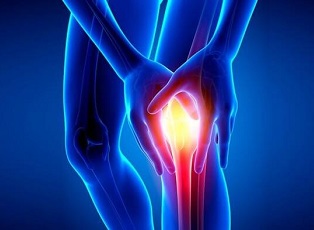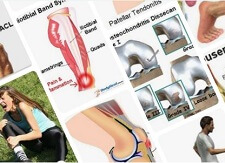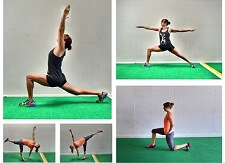- Home
- Common Knee Conditions
- Hamstring Tendonitis
Hamstring Tendonitis
Written By: Chloe Wilson, BSc(Hons) Physiotherapy
Reviewed by: KPE Medical Review Board
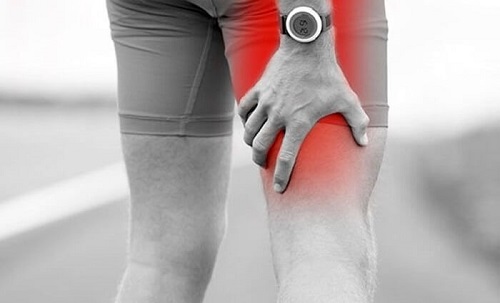
Hamstring tendonitis is a common problem causing inflammation and irritation in the tendons on the back of the thigh.
In most cases, it’s an overuse injury from repetitive sporting activities such as running, kicking and jumping.
It can affect any of the three hamstring muscles, either at the top of the thigh or at the back of the knee.
Here we are going to look at what hamstring tendonitis is, the common causes and symptoms, the best treatment options and how to prevent it.
What Is Hamstring Tendonitis?
Hamstring tendonitis, aka hamstring tendinopathy, is a condition where there is inflammation or irritation of one or more of the hamstring tendons.
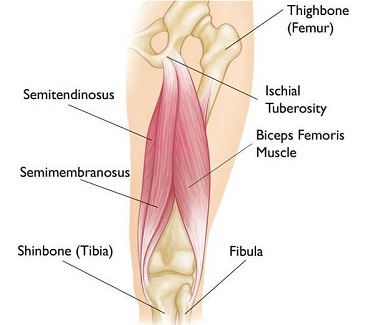
There are three hamstring muscles found on the back of the thigh:
- Semimembranosus: on the inner side of the back of the thigh
- Semitendinosus: underneath semimembranosus on the inner side
- Biceps Femoris: on the outer side of the back of the thigh
The three hamstring muscles work together to bend the knee and extend (straighten) the hip.
Tendons are thick, strong bands of flexible tissue that connect muscles to bones. There are tendons at the top of the hamstring muscles that connect the muscles to the pelvis at the ischial tuberosity, and tendons at the bottom that attach the muscles to the back of the knee. Overuse or overloading of the hamstring tendons causes acute inflammation and irritation of the tendon.
In some cases, small microscopic tears may also occur in the tendon and over time the wear and tear on the tendon leads to degeneration, and disorganisation of the tendon fibres, known as hamstring tendinosis.
Hamstring tendinosis is a more chronic condition where there is thickening and scarring in the tendon, which takes much longer to heal than an acute case of hamstring tendonitis where there is simply inflammation.
Hamstring tendinopathy can be split into two different areas:
- High Hamstring Tendonitis: affects the tendons that attach the hamstring muscles to the hip/pelvis aka proximal hamstring tendonitis causing lower buttock/upper thigh pain
- Low Hamstring Tendonitis: affects the tendons that attach the hamstring muscles to the back of the knee aka distal hamstring tendonitis causing pain behind the knee
Hamstring tendinopathy can occur either at the pelvis or the knee, but high hamstring tendonitis is more common than low tendonitis.
What Causes Hamstring Tendonitis?
Hamstring tendinopathy is typically an overuse injury where repetitive stress on the tendon leads to inflammation and irritation. Common causes of hamstring tendonitis are:
- Overuse And Repetitive Strain: Engaging in activities that involve repetitive movements, quick changes of direction or excessive stress on the hamstring tendons, such as running, jumping or kicking, can lead to hamstring tendonitis over time. Continuous strain without adequate rest and recovery can irritate and inflame the tendons. Hamstring tendonitis is a common problem for runners (both long distance and sprinters), cyclists, footballers and swimmers.
- Muscle Imbalances: Imbalances between the hamstring muscles and their opposing muscle groups, the quadriceps, often increases the risk of developing hamstring tendonitis. When one muscle group is significantly stronger or tighter than the other, it can lead to increased strain on the tendons during movement.
- Inadequate Flexibility and Mobility: Tightness in the hamstring muscles or surrounding structures, such as the hip or lower back, can increase the strain on the hamstring tendons, making them more prone to inflammation and irritation. Insufficient stretching, stiffness or limited mobility in these areas can contribute to hamstring tendonitis.
- Technique Problems: Incorrect movement patterns or poor form during physical activities can put undue stress on the hamstring tendons. Overtraining, improper technique, sudden changes in activity levels, or inadequate warm-up can all contribute to the development of hamstring tendonitis.
- Previous Injuries: A history of hamstring injuries e.g. previous episodes of tendonitis or hamstring tears can weaken the tendons and make them more susceptible to inflammation, particularly if you haven’t rehabbed properly. Proper healing and rehabilitation after an initial injury are crucial to prevent recurring issues. Other knee injuries e.g. meniscus tear or ligament sprain can also increase the risk of developing hamstring tendonitis.
- Altered Biomechanics: Anything which affects the normal biomechanics of the lower limb e.g. flat feet or wide Q angle at the hip will change the way the forces are directed through the muscle and bones of the leg which can increase the risk of hamstring tendonitis.
- Aging And Degeneration: tendons lose elasticity and naturally become less flexible and less strong with age making them more prone to injury. The degenerative changes associated with aging can make the tendons less resilient and increase the risk of developing hamstring tendonitis.
Hamstring Tendonitis Symptoms
Hamstring tendonitis symptoms usually develop gradually and may include:
- Pain Or Tenderness: Hamstring tendonitis typically presents as dull, aching pain, soreness or tenderness in the back of the thigh. You may get sharp pain if you suddenly overstretch or overload the affected hamstring. High hamstring tendonitis will cause pain in the upper thigh that may radiate to the buttock or hip, and low hamstring tendonitis will cause pain behind the knee that may radiate down the back of the calf. The exact location will depend on which tendon is affected.
- Worse During/After Activity: The pain associated with hamstring tendonitis tends to be exacerbated during activities that involve the use of the hamstring muscles e.g. running, jumping, kicking and the pain gradually gets worse the more you do. The pain usually subsides with rest but returns, often more quickly, upon resuming activity.
- Stiffness and Limited Range Of Motion: Tendonitis can lead to stiffness in the hamstring muscles and limited flexibility in the affected knee and hip. Stretching or attempting to fully bend or extend the leg might result in discomfort or a pulling sensation, causing problems with daily activities such as walking or going up and down stairs
- Swelling And Warmth: In some cases, hamstring tendonitis may cause localized warmth and swelling behind the knee and in the back of the thigh. This is often a sign of inflammation in the tendons and surrounding tissues.
- Weakness Or Difficulty With Strength-Related Activities: As the tendons become irritated and painful, it can affect the strength and function of the hamstring muscles. This can manifest as weakness or difficulty with activities such as climbing stairs, squatting, or performing explosive movements.
The location of the distal hamstring tendonitis symptoms will depend on which tendon is affected:
- Bicep Femoris Tendonitis: outer knee pain
- Semitendinosus Tendonitis: inner knee pain
- Semimembranosus Tendonitis: inner knee pain, typically slightly lower down and further inwards than with semitendinosus tendonitis
Diagnosing Hamstring Tendinopathy
The diagnostic process for hamstring tendonitis usually involves:
- Medical History: Your doctor or physical therapist will start by discussing your medical history, including any previous injuries, activities, or factors that may contribute to the development of hamstring tendonitis. This helps provide context and identify potential causes or risk factors.
- Physical Examination: They will then carry out a physical examination to assess the affected area. They will evaluate the range of motion, strength, and flexibility at the knee, hip and lower back, look for areas of muscle tightness/weakness and palpate the hamstring tendons to check for tenderness, swelling, or irregularities.
- Functional Assessment: Assessing your functional abilities can provide valuable information about the impact of the condition on daily activities. This may involve observing and analysing movements such as walking, running, standing on your tiptoes or performing specific exercises to assess pain, limitations, or compensatory patterns.
- Imaging Studies: In some cases, imaging studies such as ultrasound or magnetic resonance imaging (MRI) may be recommended. These can help visualize the tendons, assess the extent of inflammation or damage, and rule out other potential causes of pain.
Throughout the diagnostic process, your doctor will consider other possible causes of similar symptoms, such as muscle strains, nerve impingements, or referred pain from the lower back. This helps ensure an accurate diagnosis and appropriate treatment plan.
Hamstring Tendonitis Treatment
Hamstring tendonitis treatment aims to first reduce pain and inflammation in the tendon and then address the underlying cause of the tendonitis such as muscle imbalance or training errors. Typical treatment for hamstring tendonitis usually involves a combination of:
#CommissionsEarned from Amazon on qualifying purchases
1. P.R.I.C.E.
The best place to start with hamstring tendonitis is P.R.I.C.E.:
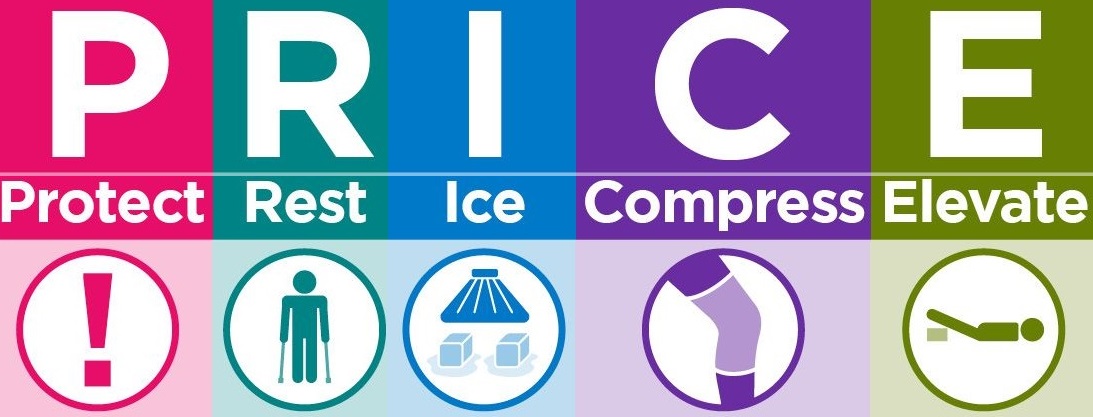
- Protect & Rest: from aggravating activities. Try and avoid any activities which bring on your pain e.g. running, jumping and kicking. But don’t stop moving altogether otherwise the tendon will quickly become tight and tense – try gently bending and straightening the knee and hip without pushing in to pain. Find Out More >
- Ice: regularly applying an ice pack for 10-15 minutes to the affected area helps to reduce the pain and inflammation associated with hamstring tendonitis. Find out more about how to get the best results from ice therapy for tendonitis in the ice treatment section
- Compression: if there is any swelling in the area, wearing a tubigrip compression bandage can help to reduce the inflammation. Find Out More >
- Elevation: Keeping the leg elevated helps to reduce any swelling in or around the tendon. One of the best ways to do this is to prop your knee up on a leg cushion.
2. Medications
Over-the-counter painkillers e.g. acetaminophen/paracetamol and non-steroidal anti-inflammatories (NSAIDs) e.g. Advil/ibuprofen help to reduce tendonitis pain and inflammation. Always check with your doctor or pharmacist before taking any medications.
3. Hamstring Tendonitis Exercises
Exercises are a really important part of treatment for hamstring tendonitis. The best place to start is with hamstring strengthening exercises and hamstring stretches to improve strength, endurance, flexibility and mobility, and reduce the tension and force through the tendon.
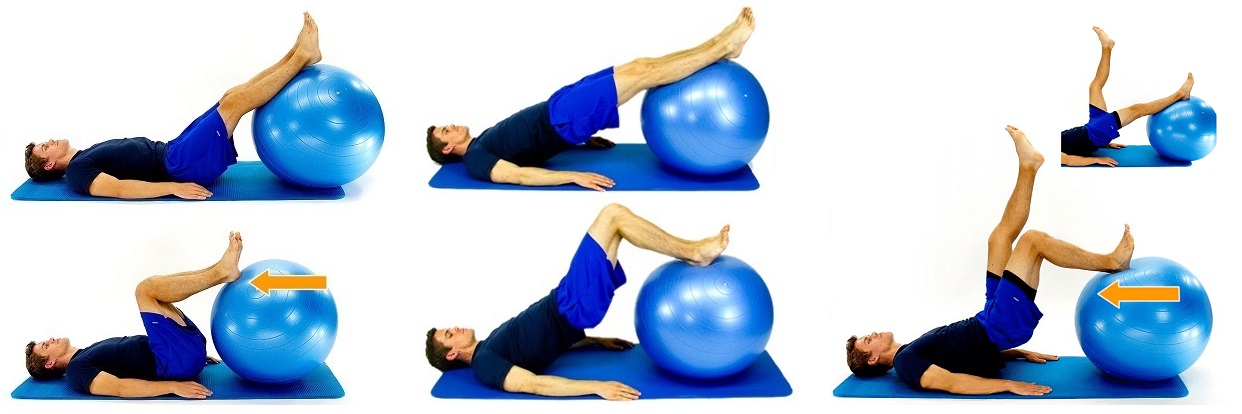
It can also really help to strengthen and stretch the other knee muscles to combat any areas of weakness, tightness or muscle imbalance, particularly strengthening the quads and glute muscles.
4. Physical Therapy
A physical therapist will be able to design a tailored rehab program for you to address the causes and symptoms of your hamstring tendonitis. They may also use other treatments such as manual therapy, deep transverse friction massage, ultrasound or electrical stimulation to aid the healing process.
5. Brace For Hamstring Tendonitis
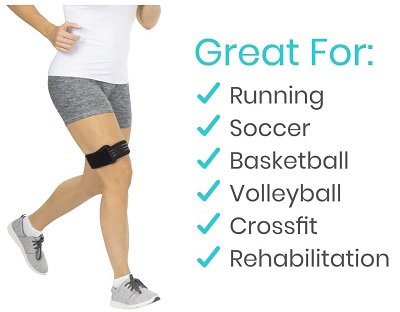
Often with hamstring tendonitis, it can really help to wear a knee brace or strap to off-load the affected tendon and reduce the strain and tension through it.
Braces are most helpful with distal hamstring tendonitis, particularly knee straps. Ideally, they should only be worn when you are exercising or playing sports otherwise the muscles may gradually weaken as your body learns to rely on the brace. Find Out More >
6. Orthotics
If altered foot biomechanics is contributing to your hamstring tendinopathy, then it can help to wear special orthotics in your shoes. This may involve arch supports to correct flat feet, or heel raises to combat any leg length discrepancies.
7. Injections
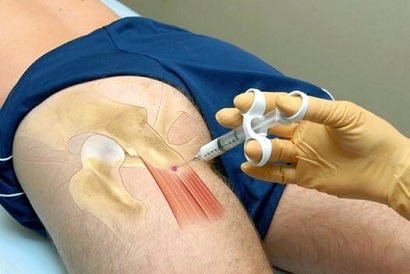
You doctor may recommend a steroid injection to help reduce hamstring tendonitis pain and inflammation.
This usually involves injecting a combination of local anaesthetic and corticosteroid either directly into the affected tendon or into the tissues surrounding the tendon.
The effects can last anything from a few days to a few weeks/months. But be aware that steroid injections do temporarily weaken the tendon so any strenuous activity should be avoid for 3-4 days to reduce the risk of tendon rupture.
8. Gradual Return To Activities
Once symptoms of hamstring tendonitis begin to improve, a gradual return to activity is recommended. This involves a progressive increase in intensity, duration, and frequency of exercises or sports, while closely monitoring for any recurrence of symptoms. It's important to listen to your body and not rush the return to full activity. If it hurts, stop. It is not a case of no pain no gain with tendonitis, quite the opposite.
9. Surgery
In most cases, non-surgical treatments are more than sufficient with hamstring tendonitis, but if symptoms fail to improve after 6 months of conservation (i.e. non-operative) treatment, or there is a large tear or complete rupture of the tendon, then surgery may be advised.
Recovery Process
The recovery time for hamstring tendonitis can vary significantly depending on several factors, including the severity of the injury, individual healing ability, adherence to treatment, and proper rehabilitation.
Mild cases of hamstring tendonitis typically resolve within a few weeks with appropriate rest, activity modification, and conservative treatment measures. This may involve resting the affected leg, applying ice, taking pain-relieving medication as directed, and engaging in gentle stretching exercises.
Moderate to severe cases of hamstring tendonitis often require a longer recovery period, ranging from several weeks to a few months. In addition to the aforementioned conservative treatments, a structured rehabilitation program under the guidance of a physical therapist becomes crucial.
It is really important to make sure you continue with your hamstring tendonitis treatment plan until you have made a full recovery. It can be tempting to stop exercises or to start pushing yourself to early, before the muscle has regained full strength and flexibility which will make it much more prone to further injuries. A good guide is to keep going with treatments, particularly exercises, daily until your symptoms have fully resolved, then keep doing them three times a week for another month. As long as your symptoms don’t return, you can then stop your rehab programme, but if you get any niggles again in the future, dive straight back into your exercise programme to get on top of it quickly.
It's important to note that every individual's healing process is different, and some individuals may require more time to fully recover. Consistency and adherence to the recommended treatment plan, along with proper rest and rehabilitation, can significantly speed up the healing process.
During the recovery period, it's essential to listen to your body's signals. Pushing too hard or returning to activities too soon can delay healing and increase the risk of re-injury. Remember, patience and proper care are key components of the recovery process with hamstring tendonitis.
How To Avoid Hamstring Tendonitis
Preventing hamstring tendonitis involves a combination of strategies that focus on reducing the risk of overuse, improving flexibility and strength, and maintaining proper technique during physical activities:
- Gradual Training Progression: Avoid sudden increases in intensity, duration, or frequency of physical activities. Gradually progress training to allow the body time to adapt and strengthen the muscles and tendons.
- Warm-Up And Cool-Down: Always include a proper warm-up and cool-down routine before and after physical activities. This should involve dynamic stretches, light aerobic exercises, and movements specific to the activity to increase blood flow, warm up the muscles, and prepare them for exercise.
- Stretching And Flexibility Exercises: Incorporate regular stretching exercises that target the hamstring muscles and surrounding muscle groups. This helps maintain flexibility and reduces the risk of muscle imbalances that can strain the tendons.
- Strengthening Exercises: Include strengthening exercises for the hamstring muscles as part of your overall fitness routine. Focus on exercises that target both the hip and knee joints to ensure balanced strength.
- Think About Your Technique: Having good technique and form with activities that involve the use of the hamstring muscles, such as running, jumping, or kicking is key. Working with a coach, trainer, or physical therapist can help ensure you are using the correct movement patterns and minimize stress on the tendons.
- Cross-Training And Variety: Incorporate cross-training and vary your activities to reduce the repetitive stress on the hamstrings. For example, if you are a runner, incorporate cycling you’re your training plan, or if you’re a cyclist, try swimming. Engaging in a variety of exercises and sports can help prevent overuse injuries.
- Adequate Rest And Recovery: Allow your body sufficient time for rest and recovery between workouts or intense activities. This allows the muscles and tendons to heal and adapt to the stress placed on them, reducing the risk of developing knee tendonitis.
- Listen To Your Body: Pay attention to any early warning signs, such as muscle tightness, discomfort, or fatigue. If you experience any symptoms, modify or reduce the intensity of your activities and seek appropriate treatment if necessary.
Remember, prevention is key to avoiding hamstring tendonitis. By implementing these strategies, you can reduce the risk of developing this condition and maintain optimal lower limb health.
Hamstring Tendonitis Summary
Hamstring tendonitis is caused by inflammation and irritation of one of the hamstring tendons on the back of the thigh.
Low hamstring tendonitis is a common cause of pain behind the knee and high hamstring tendonitis causes pain in the back of the thigh, towards the buttocks.
Hamstring tendinopathy is typically an overuse injury from repetitive movements such as running, kicking or jumping. It typically causes a dull, aching pain with activity with occasional bursts of sharp pain.
Treatment for hamstring tendonitis usually involves a rest and medications initially to get the pain and inflammation under control, and then a combination of strengthening and stretching exercises, physical therapy, injections and occasionally surgery.
Low hamstring tendonitis can also benefit from wearing a knee strap to off-load the tendon during activity.
It can take anything from a few weeks to a few months to recover from hamstring tendonitis.
You may also be interested in the following articles:
- Pain Behind The Knee
- Swelling Behind The Knee
- Hip Tendonitis
- Front Knee Pain
- Pain Below The Knee
- Calf Pain
- How To Do Stairs With Knee Pain
- Quadriceps Tendonitis
Related Articles
References
- International Journal Of Sports Physical Therapy. Proximal Hamstring Tendinopathy: A Systematic Review of Interventions. April 21
- Radiology Case Reports. Isolated distal semitendinosus tendon tear in a collegiate athlete. Dec 22
- Radiopaedia. Hamstring Injury. Dec 22
Last Updated: September 10th, 2025
Next Review Due: September 10th, 2027

